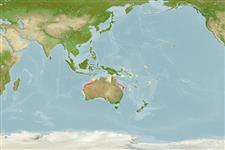Teleostei (teleosts) >
Perciformes/Scorpaenoidei (Scorpionfishes) >
Triglidae (Searobins) > Pterygotriglinae
Etymology: Pterygotrigla: Greek, pterigion, diminutive of pteryx = wing, fin + Greek, trigla, es = red mullet (Ref. 45335); draiggoch: Named after the Welsh dragon, 'draig' for dragon and 'goch' for red; noun in apposition.
More on authors: Richards, Yato & Last.
Environment: milieu / climate zone / depth range / distribution range
Ecology
Marine; benthopelagic; depth range 80 - 185 m (Ref. 54796). Tropical
Eastern Indian Ocean: Australia.
Size / Weight / Age
Maturity: Lm ? range ? - ? cm
Max length : 22.1 cm SL male/unsexed; (Ref. 54796)
Short description
Identification keys | Morphology | Morphometrics
Vertebrae: 27. This species possess the following distinguishing characters: cleithral spine, 5-9% SL), ventral to the opercular spine; a black blotch on the between dorsal-fin spines 3-5, rarely up on 6th spine; naked prepectoral and interpelvic area, usually scaled breast, scaled belly; pectoral fin dark with 13 connected rays, often with several white or light spots on lateral edge of black area and 2-3 dark spots on upper edge of fin, pectoral length 39-50% SL, longest pectoral free ray 31-45% SL; 0-2 epibranchial gill rakers, 5-10 ceratobranchial gill rakers, short (2% SL); 27 vertebrae (Ref. 54796).
Life cycle and mating behavior
Maturity | Reproduction | Spawning | Eggs | Fecundity | Larvae
Richards, W.J., T. Yato and P.R. Last, 2003. Revision of the gurnard fish subgenus Otohime (Triglidae: Pterygotrigla). Smithiana, Bull. 2:1-18. (Ref. 54796)
IUCN Red List Status (Ref. 130435: Version 2024-1)
Threat to humans
Harmless
Human uses
Fisheries: of potential interest
Tools
Special reports
Download XML
Internet sources
Estimates based on models
Preferred temperature (Ref.
123201): 20.3 - 24.3, mean 22.8 °C (based on 16 cells).
Phylogenetic diversity index (Ref.
82804): PD
50 = 0.5000 [Uniqueness, from 0.5 = low to 2.0 = high].
Bayesian length-weight: a=0.01259 (0.00513 - 0.03091), b=3.01 (2.80 - 3.22), in cm total length, based on LWR estimates for this (Sub)family-body shape (Ref.
93245).
Trophic level (Ref.
69278): 3.7 ±0.6 se; based on size and trophs of closest relatives
Resilience (Ref.
120179): Medium, minimum population doubling time 1.4 - 4.4 years (Preliminary K or Fecundity.).
Fishing Vulnerability (Ref.
59153): Low vulnerability (17 of 100).
